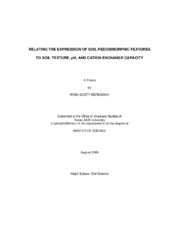| dc.description.abstract | Three laboratory studies were performed to elucidate the influence of soil
texture, pH, and cation exchange capacity (CEC) on the concentration of ferrous Fe in
soil solution and the resulting expression of soil redoximorphic features. The objectives
were: 1) assess the buffering effects of CEC on ferrous Fe concentration in soil solution,
2) evaluate the effects of pH on the concentration of ferrous Fe in soil solution, and 3)
observe the expression of redoximorphic features in soils with varying texture and CEC.
The studies concentrated on seasonally wet soils from the Texas Gulf Coast
Prairie. Selected soils included Alfisols and Vertisols with characteristics ranging from
coarse-loamy to very-fine in texture, strongly acidic to neutral in soil reaction, and
siliceous, mixed, and smectitic in mineralogy. The soils included the Pledger clay
microlow (acidic, fine-textured), Pledger clay microhigh (neutral, fine-textured), China
clay (acidic, fine-textured), Cieno loam (acidic, fine-loamy), Orelia sandy clay loam
(neutral, fine-loamy), Gessner fine sandy loam (acidic, coarse-loamy), and Orelia fine
sandy loam (neutral, coarse-loamy).
The studies provided the following information: 1) fine-textured soils with
higher CEC contained more ferrous Fe in solution, 2) ferrous Fe concentrations in the
acidic fine-loamy and coarse-loamy soils were higher than the neutral soils for the same textural class, 3) acidic and neutral fine-textured soils contained more ferrous Fe in
solution than the remaining soils, 4) the highest percentage of redox concentrations was
observed in the acidic, fine-textured soil, 5) the acidic fine-loamy and coarse-loamy soils
exhibited a greater percentage of Fe depletions, and 6) a higher percentage of redox
features were observed by micromorphic analysis (i.e., point counts under a binocular
stereoscopic microscope) than by macromorphic descriptions. This research showed
that differing soil characteristics affect the reductive dissolution and translocation of Fe,
and subsequent formation of redox features. | en |


